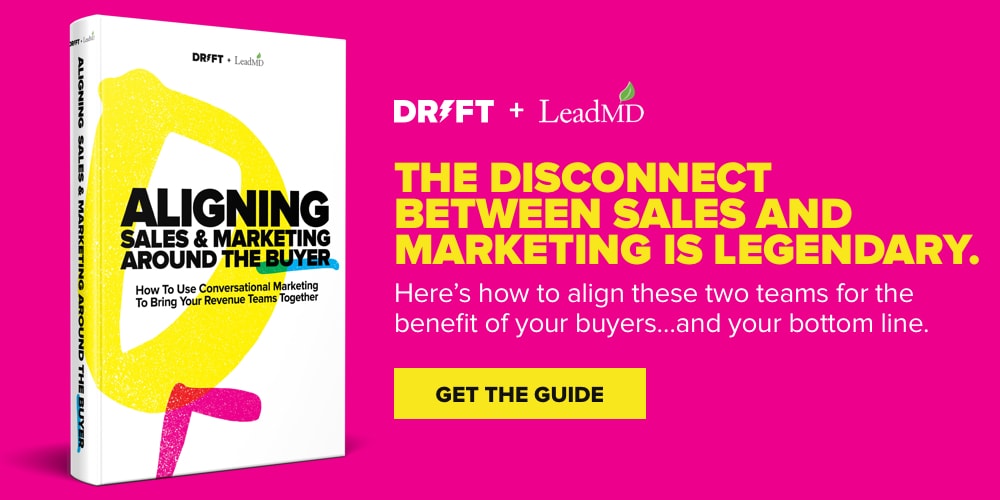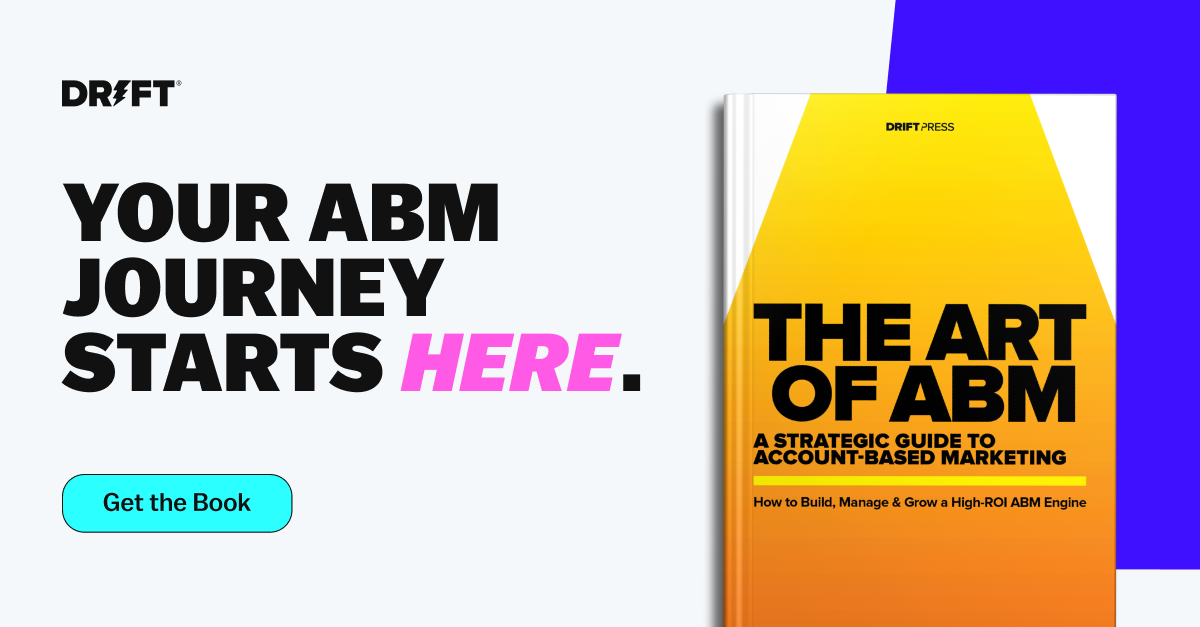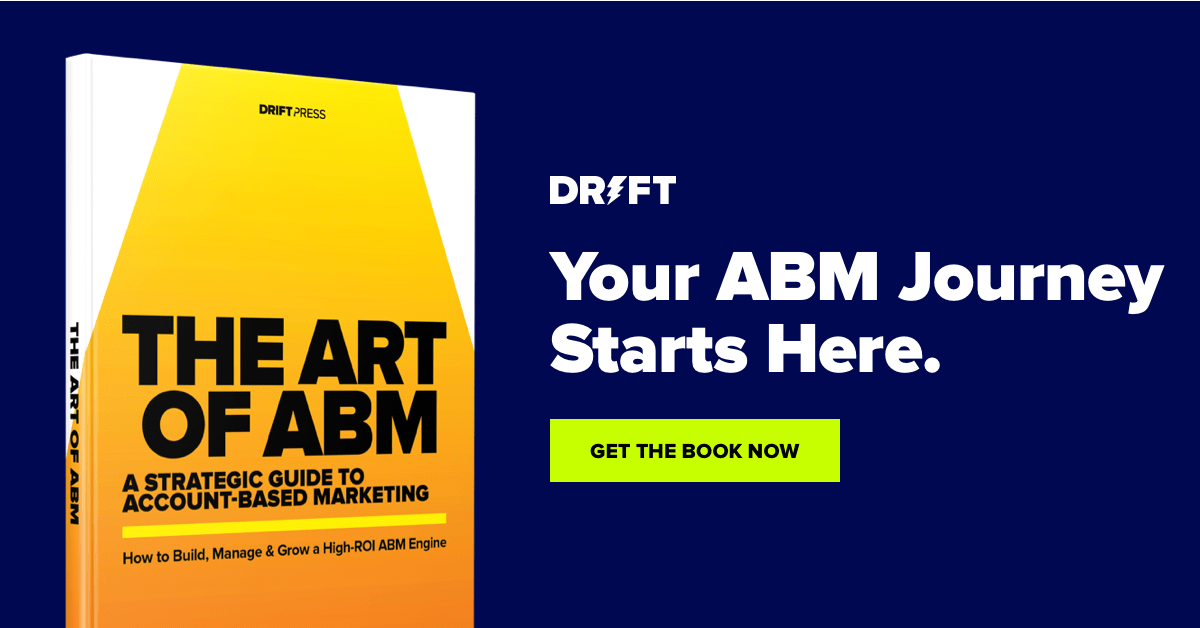A long, long time ago, in a time known as “the 2000s,” marketers focused on casting super-wide nets in the hopes of pulling in as many leads as possible.
Blog posts became content farms, covering topics that were meant to attract anyone and everyone. As far as marketers were concerned, the more traffic they could send to their sites, the better.
Their underlying philosophy at the time: Get enough fish into the net, and you were bound to have a few keepers in there somewhere. Keep your fingers crossed! 🤞
Over the years, however, an alternative philosophy began to develop, one that isn’t as much a net as a spear — account-based marketing.
In this blog, we’ll cover everything you need to know about account-based marketing, including:
Table of Contents
- What is Account-Based Marketing (ABM)
- How Account-Based Marketing & Inbound Marketing Work Together
- Benefits of Account-Based Marketing
- Building An Account-Based Marketing Campaign
- Examples of Account-Based Marketing Campaigns
- How Conversations Are Changing Account-Based Marketing
What is Account-Based Marketing?
Account-based marketing (ABM) is a form of marketing that uses highly targeted, personalized campaigns to win over particular accounts.
Rather than relying on blanket campaigns meant to appeal to an entire market, ABM treats “individual accounts as markets in their own right” (ITSMA).
When it comes to closing a deal, it’s rarely a single team member making the decision. Particularly with enterprise deals, it’s estimated that six to 10 people are involved in the decision-making process. ABM differs from other types of marketing in that it acknowledges all the different people — and different viewpoints — that comprise each account.
How Account-Based Marketing & Inbound Marketing Work Together
Using both inbound and outbound tactics in your overall marketing strategy is a highly effective way to drive results for your business. Inbound marketing is a more organic way of drawing in customers by promoting brand awareness and using strategic content to get them to engage with your business. On the other hand, outbound marketing involves strategic outreach and engagement with your target audience to create lead generation.
ABM plays into this outbound strategy. Typically, this involves selecting a handful of dream accounts that match your ideal customer profile (ICP). These will be the high-value accounts that you know you can successfully study, engage, and convert in the sales process.
But inbound marketing can also aid in finding these dream accounts. To use the fish analogy again, once you’ve got a bunch of fish in your inbound net 🎣, you can use your ABM spear 🎯to go after the highest value accounts.
Plus, when you use inbound and ABM strategies together, three things happen:
- All of your inbound efforts give you more data to work with to create more detailed buyer personas and ICPs to use in your ABM strategy.
- You have more bandwidth to grow a customer experience that’s on-brand and sets you apart from the competition.
- The content you are creating for your broader audience can often be tailored to your ABM accounts, which means you don’t have to reinvent the wheel every time.
Benefits of Account-Based Marketing
Now the question is: What happens to your business when you implement an ABM strategy? What sort of outcomes can you expect both internally and externally?
Below are some of the benefits that ABM brings to your demand generation funnel, and how you’ll stand out from the competition.
1. Strong Alignment Between Sales & Marketing
For years, marketers have been trained to write and create campaigns for people in particular markets and industries. Meanwhile, sales have been focused on engaging with only those accounts that are likely to buy. With ABM, sales and marketing are both working towards converting the same list of target accounts.
This means arguments over lead quantity and lead quality go away, and your sales and marketing teams become unified in their focus.
According to Forrester Research, organizations with aligned sales and marketing teams see an average of 32% annual revenue growth, while less aligned companies see a 7% decline in growth.
2. An Efficient and Optimized Marketing & Sales Funnel
Since ABM is so targeted with its marketing efforts, resource waste is limited.
Remember, ABM is fishing with a spear, not a net. You won’t be catching nearly as many unqualified prospects since you’re only engaging with customers that are likely to buy. Combine that narrow focus with an amazing customer experience (more on that below) and conversion rates start to climb.
3. Better Customer Experiences
Instead of going broad and blasting folks with content that appeals to a market or industry, with ABM, you go deep. You research and design campaigns specifically for one account so that every touchpoint along the buyer’s journey is personalized.
At Drift, we’re obsessed with putting the customer first, so this aspect of ABM aligns perfectly with how we run things. Instead of doing what’s convenient for the company (like automating everything and reusing the same content for all your leads), ABM puts the focus on what’s convenient for the stakeholders within your target accounts.
4. Return On Investment
Marketing’s biggest challenge has always been justifying budget. But something worth relaying to your company’s decision-makers is how ABM is measurable and provides high ROI. In fact, ITSMA’s 2020 ABM benchmark study found that 76% of marketers saw higher ROI with ABM than with other types of marketing.
And while one survey likely won’t be enough to convince leaders that ABM is worth it, you can convince them by running a pilot program and proving ROI.
5. Sales Cycle Acceleration
Because sales and marketing are pinpointing target accounts when using ABM, they notice an acceleration in their sales cycles. This is also because ABM puts prospects on a buyer’s journey that is intentionally designed to entice them quicker and build trust faster than your average marketing program.
6. Maximized Business Relevance Amidst Competitors
Since ABM allows you to give personalized solutions, your prospects and customers leave every conversation feeling like their problems have been addressed and given specific, targeted answers. Ideal customers will feel more connected to your business, and are therefore more likely to make a purchase.
In short: ABM gives you the opportunity to make an impression on high-value accounts where other companies may not be able to.
Building an Account-Based Marketing Campaign
With a better idea of the “why” behind ABM, let’s dig into the fundamental building blocks of an ABM campaign. Here are the most important steps to follow if you want to create a campaign that converts 👇
1. Select Your Target Accounts
The first and most important step of any ABM campaign is identifying target accounts.
A general rule of thumb for creating target account lists is that, the closer you get to revenue (i.e. the inner circle as shown below), the more you should invest in personalization and outreach.
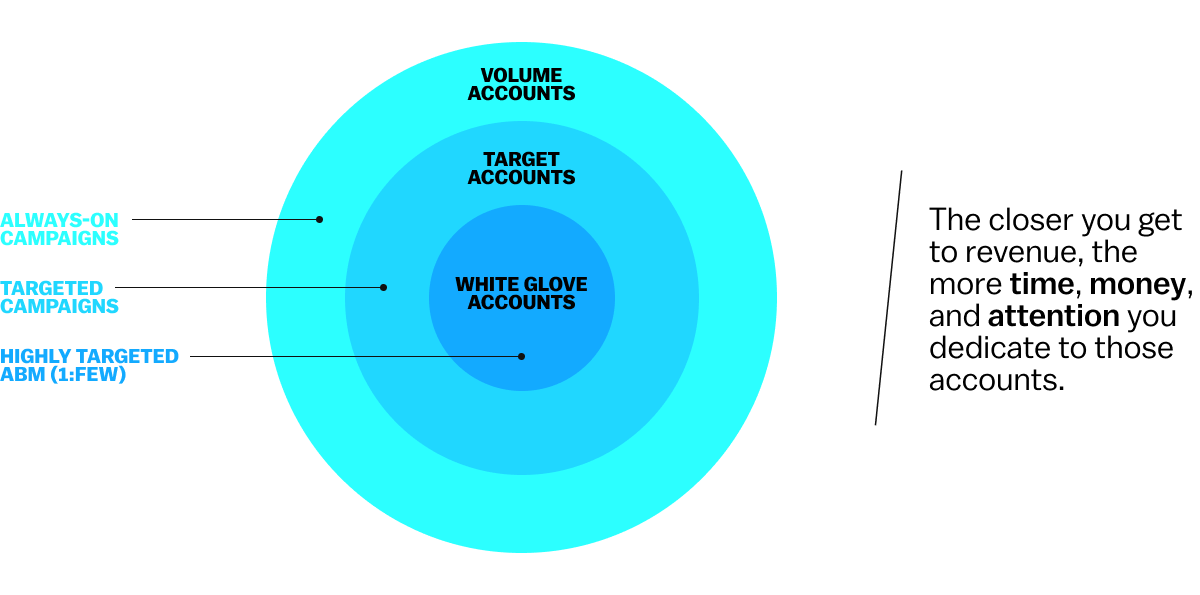
But marketers shouldn’t be picking these accounts in isolation. Without aligning with sales from the start, you lose the opportunity to select the target accounts that they agree reflect the company’s ICPs. And that agreement is critically important to launching your ABM strategy.
2. Align with Sales & Develop Follow-up SLAs
The collaboration between marketing and sales doesn’t end after the target account list is finalized. For ABM to be successful, marketing and sales teams need to be aligned every step of the way.
Often, marketing owns the setup and execution of campaigns, while sales focuses on following up with and converting target accounts. It’s a team effort. Here are three ways to encourage your teams to come together on your ABM campaigns:
- Create a robust communication strategy: Communication is key to any successful collaboration. Set up weekly, monthly, and quarterly check-ins where you brainstorm ABM strategies, review results, and plan for future campaigns.
- Keep activities and messaging transparent: While marketing and sales are responsible for different activities, they should always be promoting the same value proposition. Both teams should agree on messaging and rules of engagement — like who to target or when outreach happens — so that your accounts aren’t being told two different things at once.
- Establish clear service-level agreements (SLAs): To avoid any friction between teams, sales and marketing should decide on key performance indicators (KPIs), deliverables, and timetables to hold each other accountable.
3. Choose Your Account-Based Marketing Channels & Offers
No two ABM strategies are the same. That means the channels and offers you choose will entirely depend on your approach to ABM — the level of investment in each account.
For example, in a one-to-one strategy, you can make your account feel special by sending a personalized gift through direct mail. Whereas, in a one-to-many approach, it’s a better use of your time to create targeted marketing experiences, like an industry-specific webpage or a personalized email.
Here’s an example of how your channels and offers might differ between volume (or inbound) accounts, target accounts, and your one-to-one ABM accounts 👇
In short, you will want to experiment with a mix of channels and offers to figure out the best way to engage with your top-tier accounts. The bottom line is that you want to put your efforts into the channels that are most relevant to your ABM accounts — because that is how you can really grab their attention.
After you’ve gathered all the data and information you need to successfully inform your campaign strategy, you can start creating content for your targeted accounts with your intended audience in mind. Whether the content is targeted or broad, it should all play into your overall campaign strategy.
4. Measure Your ABM Campaign
Once your campaign is up and running, you can start measuring KPIs to help you determine the success of your campaign. Things like click-through rates on emails, reach on social posts, and lead-to-customer conversation rates are all helpful in determining the impact of your campaign.
Wondering how to measure the success of your ABM campaign? You’re in luck! Check out Drift’s Integrated Marketing Campaign Toolkit to learn how to measure, track, and analyze your integrated marketing campaigns easily.
Examples of Account-Based Marketing Campaigns
It’s one thing to hear all this good stuff about ABM and how much growth it can bring to your business. But it’s another thing to see it in action.
Here are two great examples of successful ABM campaigns we’ve come across.
Terminus’ Air Cover, Event Marketing, & Pipeline Acceleration Campaigns
Why run one ABM campaign when you can have three?
In 2016, Terminus ran three distinct ABM campaigns in parallel — Air Cover, Event Marketing, and Pipeline Acceleration — which brought together multiple channels to create a personalized buying experience that spanned the entire buying journey. Here’s a breakdown of each:
- Air Cover: As business development reps (BDRs) worked on target accounts, Terminus targeted the contacts and decision-makers within those accounts with relevant online ads to build brand awareness.
- Event Marketing: Sales and marketing would identify target accounts for events, taking into account past attendees, pre-registration lists, and accounts located near the event. After the event, Terminus followed up with ads, emails, social posts, and outreach from BDRs — all tailored to attendees.
- Pipeline Acceleration: This campaign was focused around one thing: closing deals. Sales and marketing came up with targeted messages and ads that match the account’s buying stage, from early-stage to late-stage opportunities.
Through these campaigns, Terminus ensured that their ABM accounts became aware of their brand, learned how their solution could help solve pain points, and remained constantly engaged with relevant and personalized content until the deal closed.
STANLEY SECURITY’S ABM Strategy with Drift
When it comes to selling in the digital world, nothing beats the personalized approach of ABM — because that is what builds trust and leaves a lasting impression on prospects and customers.
The STANLEY Security team took their ABM efforts one step further by engaging with target accounts throughout the buying journey using Drift.
Since account-based engagement (ABE) spans the entire customer lifecycle, the team needed a way to pinpoint intent. With Drift, they customized their chatbots and started conversations that allowed buyers to share exact needs. Not only were the chatbots able to provide a direct path to that information, but the team used the details collected, like the buyer’s industry, buying stage, and viewed pages, to personalize future website visits — without having to qualify them again.
With Drift’s help, STANLEY Security not only gave VIP prospects personalized experiences, but the team also continued providing value as those people became customers, and eventually, advocates. And their engagement strategy garnered some impressive results — more than 2,300 opportunities, a 3x higher email capture rate, and lifelong relationships with their most important customers.
How Conversations Are Changing Account-Based Marketing
Phew! That was quite the walk-through, we know. We covered a lot about ABM — how it works with inbound marketing, its benefits, the building blocks of an ABM campaign, and real-life examples of businesses that have integrated ABM into their marketing strategy.
But now you might be wondering…what do I do with all of this information? How do I deliver that red carpet experience to my target accounts, every time?
We’re here to help.
Today’s live chat software isn’t just about having conversations. It’s about having the right conversation, with the right person, at the right time.
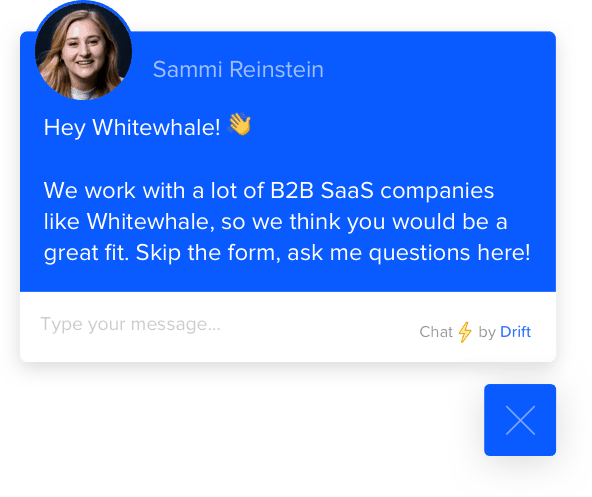
Imagine getting a push notification on your phone or desktop the instant a decision-maker from one of your target accounts lands on your website. With a swipe of your thumb, you can reach out to them proactively and in real time to provide any assistance they might need.
By targeting your ABM audience with a personalized message from their dedicated account owner, you can engage in real-time conversations that convert. With the ABM playbook for Drift Audiences, companies can:
- Choose a target account audience from Salesforce or a similar customer relationship management software (CRM) and set up a dedicated playbook.
- Notify account reps when a contact from that account lands on your website.
- Greet accounts with a personalized message the moment they arrive.

This is the type of white-glove treatment your target accounts deserve. While ABM is great for identifying key decision-makers and engaging them with personalized content, it’s only half the battle. Drift is what you need to have meaningful conversations with those decision-makers.
Because that is the secret to doing ABM successfully — so that you can impress your prospects with every interaction and build the foundation for a long-lasting customer relationship.
Learn how Drift ABM can automate and elevate your account-based marketing campaigns today.





